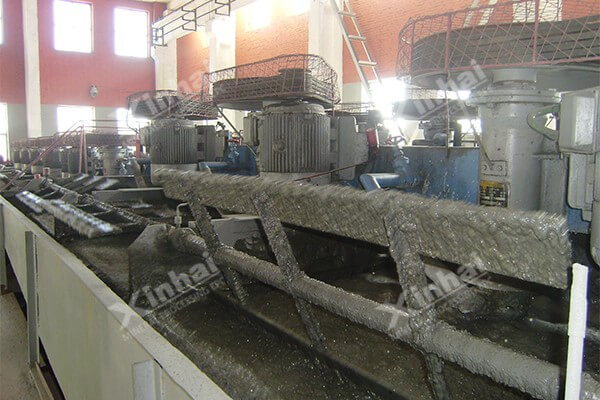

Warm Tip: If you want to know more details about equipment, solutions, etc, please click the button below for free consultation, or leave your requirements!

In this post you can see how to process ilmenite ore.
You can also know about:
Conventional flotation method
Flocculation flotation method
Reunion flotation method
Magnetic separation + flotation combined method
Gravity and flotation combined separation method
Magnetic and gravity combined separation method
Gravity-magnetic-flotation-electric combined separation method
Let's dive right in!
Ilmenite is brittle and dense. Due to the physical and chemical properties of mineral surface, it is not easy to recover coarse ilmenite by flotation process. However, fine or fine ilmenite has good floatability and can be recovered by flotation method.
In the conventional flotation process, the most commonly used collectors are oleic acid, paraffin oxide soap, tar oil and some new collectors. One of the most commonly used is oleic acid and its soap. The technology for this collector is more mature and more reliable. However, it also has one of the most significant disadvantages, is the use of too much material. Compared with the conventional collectors mentioned above, the new type of ilmenite collector has better selectivity, does not require emulsification, and has better separation effect for some minerals that are difficult to be separated. For example, in mineral processing, ilmenite and ilmenite pyroxene have close phytoplankton, so it is difficult to separate them by flotation method. With the use of some new collectors, the separation of the two can be better, greatly improving the grade of the ore.
Flocculation flotation method can be subdivided into selective flocculation method and hydrophobic flocculation method. Among them, selective flocculation refers to the combination of two or more minerals in which a single mineral is first condensed and then gradually separated. Hydrophobic flocculation is a method of separating the hydrophobic particles suspended in water by means of the hydrophobic interaction between them to attract each other and agglomerate. This method can raise the original ore grade from less than 10% to 40% to 50%, and greatly increase the recycling efficiency to reach or even exceed 50%.
The agglomeration flotation of ilmenite refers to the technology that makes ilmenite hydrophobic by means of a collector adsorbed on the surface of ilmenite, and then makes the ore particles cluster by means of the capillary gravity of the bridge solution, and then carries out the separation after floating on it. It should be noted that in the process of mineral processing by agglomeration flotation method, the strength and strength of stirring must be guaranteed at all times, so that the ore particles can more easily agglomerate to achieve the effect of concentration. In addition, the diameter of the impeller and its position in the tank will also have an impact on the flotation index. When the diameter of the impeller reaches about 50% of the diameter of the stirred tank and the impeller is about one meter from the bottom of the tank, the effect of the agglomeration flotation method will be the best.
For ilmenite dressing, a combination of methods is often better than a single dressing method, which can better improve the grade and recovery of ore. At present, the combined separation method for ilmenite in China can be roughly divided into four types: magnetic separation + flotation, gravity separation + flotation, magnetic separation + gravity separation, gravity separation - magnetic separation - flotation - electrical separation, etc.
In ilmenite dressing, it is always a difficult problem to recover the fine particle size. In mineral processing, flotation method can only to a certain extent to achieve the recovery of less than 0.02 mm of granular ilmenite, but there will be a lot of quartz and other gangue in the concentrate after flotation, which seriously affects the quality of flotation. Therefore, the ore can be magnetically sorted before flotation. After the combination of the two, the concentrate grade and total recovery will be much better than the single magnetic separation or flotation.
The recovery of ilmenite by heavy - flotation process has a good effect on the selection of ilmenite with grade less than 6%. The grade of ilmenite selected by this method can be directly raised to more than 30% after reprocessing, and the final titanium concentrate grade can reach 47% after flotation desulfurization and other processes, and the recovery rate is close to 30%, and the sulfur concentrate with a grade of 40% can be produced at the same time. It is not hard to see from the data that this method can better improve the utilization of resources.
For ilmenite, although single gravity separation or magnetic separation can complete the selection task, but the combined magnetic and heavy process is undoubtedly better, and can reduce production costs, increase efficiency. By this method, the concentrate grade and recovery rate can reach 50% and 80% respectively.
If the gangue in the raw ore is dominated by ilmenite and plagioclase, and contains sulfide minerals, it can be re selected first, cast off plagioclase, and then desulfurization by flotation method, and finally remove ilmenite by electricity. Through this combination scheme, the grade and utilization rate of ore can be improved better, and this method is also good for ilmenite with lower grade.
Ilmenite can be extracted by flotation process or combined extraction methods. We can choose suitable methods by the characteristics of ilmenite ore.
Last: 10 Ways to Improve the Grinding Efficiency of Your Ball Mill
1Ilmenite Recovery by Combined Processing Method
 0
0
 2455
2455
2How to Separate Ilmenite?
 5
5
 4137
4137
